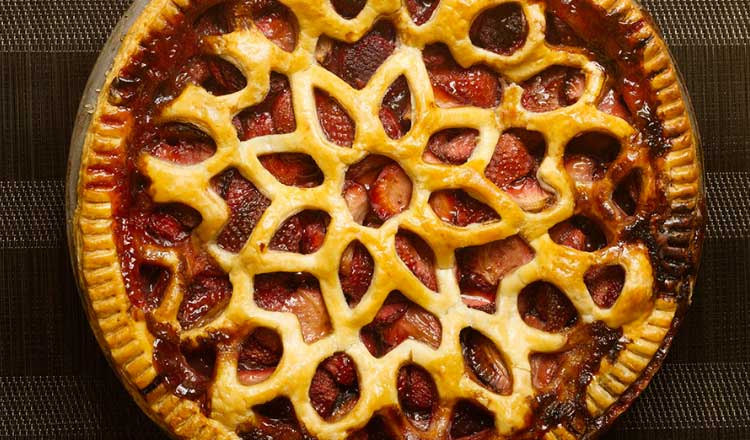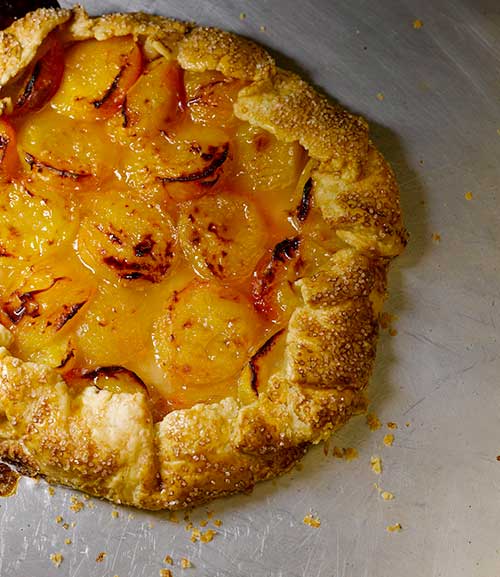
In a moment of introspection, it has occurred to us that “pie season” is sort of a disingenuous concept. We are currently in the thick of summer pie season, but also, we are on the tail end of late spring pie season. And before we know it, it will be fall, which means apple pie season. And then, of course, Thanksgiving will be upon us, which is, well, pie season.
All that to say: we don’t need an excuse to eat pie.
Our cumulative interest in pie is almost surely fueled, to some degree, by the nostalgia of the thing. They feel sort of old-fashioned, something our many-times-great grandmothers would have had cooling on a windowsill. But pies are also approachable to the infrequent and self-proclaimed “not-a-bakers.” You put fruit in the crust and bake it until it looks good. Easy as, well, pie!
That’s right, you can make a pie without a recipe. There are no rules when it comes to everyone’s favorite dessert; if it sounds good to you, you can make it. Pie pan or free-form; sweet or savory; double-crust or crunchy crumb topping; one fruit or ten. It’s your pie, and what you say goes!
Hopefully you’re hyped up enough to run into the kitchen and get baking, but in case you’re still stuck at the starting gate, here are a few general bits of guidance to help you free style a blue ribbon pie.
- This is the most important bit of information I can give you: Every Pie is a Good Pie. Say it to yourself as many times as you need. Let it be your forever mantra that provides you overwhelming confidence. Even a pie that is not as great as you had hoped is still a good pie—a great pie, even! Especially if you add ice cream.
-
If you made a quick pie dough and don’t have the time/patience to let it rest for a few hours, skip the pie pan, and make a rustic free-form pie, also known as a galette or crostata. Roll your pie crust into a rough circle and place it on a parchment paper-lined baking sheet. Arrange your filling in the center of the dough, leaving a few inches around the edges. Fold the dough in to form a crust around the filling. By taking your pie out of the pan, you can worry less about shrinkage from a hurried pie crust.

- If you’re working with especially juicy fruit, you’re going to have lots of liquid. That’s not a bad thing, and no one has ever turned down a slice of pie for being too full of flavorful fruit juices! But, if you want your pie to be sliceable, you may choose to pre-cook the fruit in the stove before adding it to the pie crust. Add some sugar and starch, like corn starch or tapioca, to help stiffen up the leftover juices. Juicy fruits are also great options for pies without full top crusts—like crumbles or lattice—because then the excess liquid can evaporate, rather than being trapped under a roof of pastry.
-
Your fruit may be nice and sweet, but you should still add a bit of sugar. Sugar helps to activate the natural pectin in your fruit, which will thicken the filling for a nicer mouthfeel and easier slicing. Use granulated sugar or brown sugar, for some richness. Counter the added sweetness with a good squeeze of lemon juice and a pinch of salt.
-
If it grows together, it goes together. This is an old saying about seasonal fruits and vegetables that holds true when it comes to pies. Mix and match the fruits that are available right now to harness the best of the season’s flavors. In the summer, that can be peaches and blackberries; in the fall, pears and cranberries; in spring, strawberry and rhubarb!
Of course, flavor additions don’t have to be limited to other fruits. Experiment with sweet and savory combinations by adding spices and herbs, as well as nut or aromatics like ginger and lemongrass. Cook your fruit with wine or vinegar before adding it to the crust, or add grated dry cheese to your pie crust.
-
Your fruit may be nice and sweet, but you should still add a bit of sugar. Sugar helps to activate the natural pectin in your fruit, which will thicken the filling for a nicer mouthfeel and easier slicing. Counter the added sweetness with a good squeeze of lemon juice.
-
Always, and we mean always, place your pie on a baking sheet for baking, rather than directly on the oven rack. Pie experimentation is fun, but it can also be messy, and a baking sheet will catch any syrupy fruit juice overflows before they reach the floor of your oven.
-
Some recipes say a pie is done when the juices of the fruit are bubbling, but the most important thing to look for in a finished pie is the crust. Take your pie out of the oven when the crust is deep golden brown all over, and not a minute sooner! An underbaked crust will be gummy, flavorless, and difficult to slice. In baking, color is flavor, and we love a nice crisp, golden pie crust.
If you still want some hands-on pie practice, come join us at one of our weekend classes, like Pies & Tarts, Holiday Pies, or Baking at Home!
